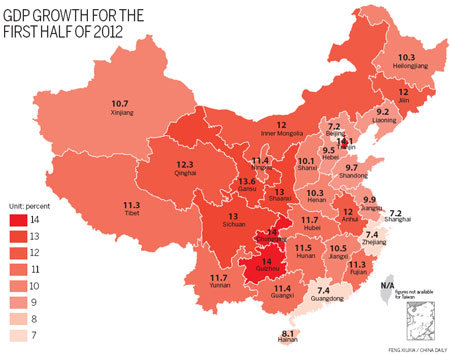Two-speed China


Inland regions keep the growth juggernaut rolling as coastal regions feel the heat
Guiyang is in one of China's poorest provinces, but the city of more than 4 million inhabitants now has an air of prosperity over it.
Last year the southwestern city had GDP growth of 17.1 percent - one of the highest anywhere in China - and more than double the current national growth rate of 7.6 percent.
The bustle of activity around the city's central Renmin Square, overlooked by an imposing statue of Chairman Mao Zedong, represents a pattern now repeated elsewhere in China.
While much of the international focus is on China's growth slowing down and the risk of a so-called hard landing, large swathes of the country, particularly in central and western areas, are enjoying unprecedented rates of growth.
This two-speed China is beginning to whet the appetite of the large multinationals as well as businesses from the rest of China that are finding that doing business in the mature coastal areas of Shanghai and Guangdong is becoming increasingly difficult.
The streets of Guiyang are not yet thronging with Western visitors, but a number of high-profile ones are already helping to put it on the global map.
|
||||
Zhang Zhi, chief executive officer of Zhongtian Urban Development Group, the Shenzhen-listed company that is one of the largest property developers in the city, has played a key role in fuelling the growth in Guiyang.
His company built the 2-million-square-meter Guiyang International Exhibition and Convention Center, which opened last year.
"The pace of growth has accelerated in the last couple of years," Zhang says. "Before, the whole of Guizhou was relatively backward since it is very much located in inner China and conditions weren't favorable for development.
"Now, new infrastructure, particularly the ring roads and highways, has laid a solid foundation for future expansion."
Zhang, 46, who was speaking from the courtyard of the Hyatt Regency Hotel, his company's own 900 million yuan ($141 million, 115 million euros) development that opened in July 2011, says increasing numbers of foreign investors have been attracted to the city.
Zhongtian itself has had major collaboration with RTKL, the US global design practice, the Japanese design group KKS, the French architecture firm Aube and the British engineering design giant W.S. Atkins.
"There is now a lot of international investment from outside, and a lot of local companies are keen to cooperate with overseas companies for their advanced know-how and technology."
Divergent trends
|
Left: Liu Qian, deputy director of the China Forecasting Service at the Economist Intelligence Unit. Right: Jack Xiao, president of Roomax Consulting based in Guangzhou. Photo by Wang Jing / China Daily (left) and Provided to China Daily |
The divergence in growth between China's coastal regions, which have been at the vanguard of China's economic growth since reform and opening up in the late 1970s, and the inner regions is now certainly marked.
According to an Economist Intelligence Unit survey, which incorporates data from the National Bureau of Statistics, growth in Beijing last year was just 8.1 percent, Shanghai 8.2 percent and in Guangzhou, a key center for China's exports, although holding up at 11 percent, was down from the 2010 level of 13.2 percent.
By contrast, the inner and western regions are motoring ahead. Growth in Chongqing, the huge metropolis in the west of China, was 16.4 percent, Sichuan 15 percent, Yunnan province in Southwest China 13.7 percent and Changsha, the capital of the central province of Hunan, 14.5 percent.
Liu Qian, deputy director of the China Forecasting Service at the Economist Intelligence Unit in Beijing, says the faster growth in part reflects that many companies are relocating there.
"With wages increasing in many of the coastal provinces, manufacturing companies have been looking for alternative locations and have been particularly attracted to some of the inland provinces. Not only are wages cheaper there but also many of them have pretty good universities," she says.
"An additional advantage for provinces like Hunan, Henan and Anhui, for example, is that they are not very far away from the coast. So with improving infrastructure, it is relatively easier to ship goods out."

Today's Top News
- China, US hold maritime safety talks in Hawaii as Beijing reiterates warnings on sovereignty
- China sends letter to UN over Japanese PM's remarks on Taiwan
- Chinese, Uzbek FMs hold second strategic dialogue
- G20 an opportunity to strengthen Sino-EU ties
- China, Africa foster shared food security
- Japan urged to take practical steps to honor its commitments to China



































